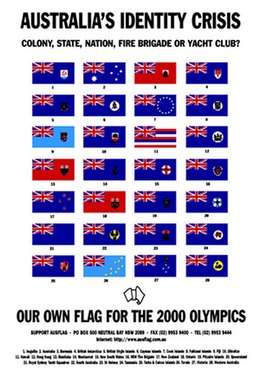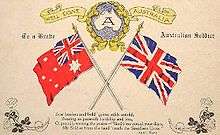Australian flag debate
The Australian flag debate is a periodic question over whether the Australian flag should be changed, particularly to remove the Union Jack from the canton, but also to possibly introduce a completely new design without the Southern Cross.[1]

The debate has often arisen in connection with the issue of republicanism in Australia. It has come to a head on a number of occasions, such as the period immediately preceding the Australian Bicentenary in 1988 and during the prime ministership of Paul Keating, who had publicly raised the topic of flag change during the early 1990s.
Arguments for a new flag

The case for changing the flag has been led by the organisation known as Ausflag. The organisation has not consistently supported one design but is opposed to the Eureka Flag and has sponsored a number of design competitions to develop alternative flag candidates.
Supporters of changing the flag have made the following arguments:
- The flag is not distinctive because it contains the national flag of another country in a position of prominence. In particular, the flag is difficult to distinguish from a variety of flags based on the British Blue Ensign, most notably the national flag of New Zealand and the state flag of Victoria. For example, when Australian prime minister Bob Hawke visited Canada in 1984, Ottawa was decked out with New Zealand flags in his honour.[2] The Australian Monarchist League, during their "No" campaign for the Australian republic referendum in 1999, displayed the New Zealand flag instead of the Australian flag in one of their pamphlets.[3] Again in 2013, the Australian Monarchist League mistakenly captioned the New Zealand flag as being the Australian flag on their website.[2][4] In 2018, a news piece about Australia Day on Nine News Queensland, the background graphics showed New Zealand flags instead of the Australian flags.[5]
- It does not accurately connote Australia's status as an independent nation. The Union Jack at the canton suggests Australia is a British colony or dependency. New Zealand, Tuvalu and Fiji are the only other independent nations in the world to feature the Union Jack on their national flags. Other Commonwealth countries whose flags originally depicted the Union Jack have since changed them without becoming republics, while Canada, whose official pre-1965 national flag was the Union Jack, also adopted a new flag design without becoming a republic. The Australian flag's colours of red, white and blue are neither Australia's official national colours (green and gold) nor its traditional heraldic colours (blue and gold).
- In representing only Australia's British heritage, the flag is anachronistic and does not reflect the change to a multicultural, pluralist society. In particular, the flag makes no mention of indigenous Australians, many of whom regard the Union Jack as a symbol of colonial oppression and dispossession.
- The existing flag is historically not the prime national symbol. For most of the time since Federation, it was flown alongside the British Union Jack which took precedence as the national flag from 1924 to 1954. Until the late 1920s the Australian Federation Flag remained more popular than the Australian flag for public and even some official events. For example, the Federation Flag was flown during the 1927 visit to Australia of the Duke and Duchess of York.[6] The number of points of the stars have varied since 1901 and the present blue version was not adopted as the "national" flag until 1954. Before then, the Union Jack took precedence and confusion reigned between whether the red or blue version of the Australian flag was to be preferred, with the red often winning out.
- It is spurious to claim that Australians have "fought and died under the flag", given that during most of the wars Australians have been involved in, they have usually "fought under" various British flags or the Australian Red Ensign.[7] Prior to 1941 only 10 per cent of military ensigns were Blue and in 1945 Red ensigns were flown along the route of the official end of war parades.[8] The flag made in secret by the Changi prisoners-of-war was a red ensign.[9] The coffins of Australia's war dead were draped with the Union Jack.[10]
- Although the flag was designed by four Australians, including two teenagers, and a man from New Zealand[11] and chosen through a public competition, the conditions of entry for the Review of Reviews competition – which was integrated into the government initiative – were highly suggestive that the winning design must include the Union Jack and Southern Cross,[12][13][14] and final approval lay with King Edward VII and, because both the red and blue versions were considered naval ensigns, the British Admiralty.[10]
- There are 52 countries in the Commonwealth of Nations – only five of them, including the United Kingdom, have the Union Jack in their own flag.
Arguments for the current flag


The Australian National Flag Association was formed to maintain the status quo.
Opponents of changing the flag have made the following arguments:
- It is a popular symbol.[15] No alternative national flag has attained the same degree of acceptance accorded to the existing flag.[1]
- The flag is a unique combination of devices recognised by law, custom and tradition as Australia's chief national symbol. It represents all Australian citizens regardless of background, race, religion or age.[16]
- According to Nigel Morris of the Australian Flag Society, it is of historical importance, being the flag "that Australia has grown up under, and the flag that has been associated with all of her many achievements on the international scene".[17]
- It was chosen through an open public competition. The competition was won by five entrants who had submitted similar designs, four Australians and a man from New Zealand, who would share the honour of being declared the designers.[11][18]
Southern Cross

The Southern Cross is thought to represent Australia's position in the Southern Hemisphere (see Southern Cross Flag). It has been used as a symbol of Australia since in the 1820s when there were crown colonies of the British Empire in Australia. The National Colonial Flag for Australia was the first such concept to depict the Southern Cross.
Some claim that the Southern Cross is not explicitly Australian but could represent any nation in the Southern Hemisphere. As well as the Australian flag, it also already appears on the flags of Brazil, Papua New Guinea, Samoa, New Zealand and Mercosur.[19]
Progress of the debate
When the winning entry to the 1901 Federal Flag Design Competition was announced the initial reception was mixed. The then republican magazine The Bulletin labelled it:[20]
a staled réchauffé of the British flag, with no artistic virtue, no national significance... Minds move slowly: and Australia is still Britain's little boy. What more natural than that he should accept his father's cut-down garments, – lacking the power to protest, and only dimly realising his will. That bastard flag is a true symbol of the bastard state of Australian opinion.[21]
|
Initially the Department of Defence resisted, considering it to be a marine ensign and favouring King's Regulations that specified the use of the Union Jack. After being approached by the Department of Defence, Prime Minister Chris Watson stated in parliament that he was not satisfied with the design of the Australian flag and that implementation of the 1904 resolution could wait until consideration was given to "adopt another [flag] which in our opinion is more appropriate."[23]
On 14 April 1954 the Flags Act 1953 (Cth) became law after receiving all-party support. Tabling the legislation in parliament, the Prime Minister, Robert Menzies, stated: "The bill is very largely a formal measure which puts into legislative form what has become almost the established practice in Australia."[24]
The first proposal for a new Australian flag was made in 1956 by the Republican Socialist League. It was an evolutionary design in which the Union Jack was replaced with the Commonwealth Star.[25]
The Bulletin magazine launched an Australian National Flag Quest on 1 August 1971 in time for the visit of Queen Elizabeth II to open the Sydney Opera House in October 1973; 10 designs were chosen from the 2,000 submitted and these were displayed by major stores in the capital cities and main provincial centres during 1972.[26]
At the July 1982 National Conference of the Australian Labor Party in Canberra, the party changed its policy platform in regard to national symbols to: "Initiate and Support moves to establish with popular acceptance an Australian flag ... which will more distinctively reflect our national independence and identity."
It was reported in The Australian newspaper on 28 January 1984 that, "It is understood that Federal Cabinet will soon decide how best to ignite the debate on the pros and cons of changing the flag before the issue is put to a national vote before the 1988 bicentenary year. The Minister for Housing and Construction Mr Chris Hurford publicly revealed yesterday that the Government had not allowed economic discussions to completely swamp cabinet debate on the flag."
The prime minister, Bob Hawke, subsequently announced in the House of Representatives that the design of the Australian flag would not be reviewed by the Australian government before or during the bicentenary year.[27]
Paul Keating publicly championed the cause of a new flag during his term as prime minister, including on a state visit to Indonesia. He was quoted as saying:
I do not believe that the symbols and the expression of the full sovereignty of Australian nationhood can ever be complete while we have a flag with the flag of another country on the corner of it.[28]
On 6 June 1994, the Sydney Morning Herald reported the deputy prime minister, Kim Beazley, as saying that the Labor government was committed to its timetable for changes to Australia's flag by the Centenary of Federation in 2001; beyond commissioning a national survey that year, no further action was taken.[29]
In opposition from 1983–1996, coalition MPs unsuccessfully sponsored 10 private members bills to amend the Flags Act 1953 (Cth) to prevent the existing Australian flag from being replaced by the agreement of both houses of federal parliament alone, without the views of the Australian people being taken into account.[30]
Frequent Morgan polls showed the percentage of Australians wanting a new flag increasing from 27% in 1979 to 42% in 1992, to a majority of 52% in 1998.[31] In response to polls showing increasing support for a new flag, the Coalition government under John Howard established Australian National Flag Day in 1996 and introduced legislation, the Flags Amendment Bill 1996, to make a change more difficult. In 2002, the Howard government supplied ANFA's promotional video free to all primary schools and in 2004 required all schools receiving federal funds to fly the Australian flag.[32]
On 24 March 1998, the Flags Amendment Bill 1996 received Royal Assent.
Malcolm Turnbull, former chairman (1993–2000) of the Australian Republican Movement and head of the official "Yes" case committee for the 1999 Australian republic referendum, left the board of Ausflag in 1994 after being asked for his resignation and in 2004 joined the Australian National Flag Association.[33]
A 2010 Morgan Poll that asked: "Do you think Australia should have a new design for our National Flag?" was supported by 29% of respondents and opposed by 66%, with 5% uncommitted.[31]
In 2015, with the flag debate in New Zealand continuing, discussion on the Australian Flag has risen in the media. This includes the issue being raised publicly by Labor MP Tim Watts.[34]
One of the influential flags designs raised into the public debate in 2015 has been The Golden Wattle Flag. It takes the golden wattle blossom as the central motive creating a negative space Commonwealth seven-pointed star. The Golden Wattle is one of Australia's first national symbols dating back to Lord Hobart. It is an endemic tree to Australia which served as a source of food and medicament as well as wood for the boomerangs for the Aborigines. [35] It is Australia's official floral emblem and it is the reason behind Australia's national colors. [36]
In 2016, designer and social enterpreneur Murray Bunton created The Unity Flag. The flag is an attempt to replace the British colonial flag with a flag that would represent all of the diverse Australian community. It consists of a "federation star" on a blue field representing the Australian night sky shared through the Australian rich history and a golden chevron representing a boomerang pointing to a white field representing the bright future, the daybreak.[37]
 Ausflag's 2000 professional designers' competition was won by Franck Gentil with a design that replaces the Union Flag with a gold Commonwealth Star
Ausflag's 2000 professional designers' competition was won by Franck Gentil with a design that replaces the Union Flag with a gold Commonwealth Star The Golden Wattle Flag
The Golden Wattle Flag The Unity Flag designed by Murray Bunton
The Unity Flag designed by Murray Bunton
See also
| Wikimedia Commons has media related to Proposed national flags of Australia. |
References
- John Huxley (26 January 2011). "Australia Day | New Union Jack Flag Debate". Theage.com.au.
- Media Release (25 January 2013). "Monarchists Prove Case for Australian Flag Change". AUSFLAG. Retrieved 7 February 2014. A similar claim has been made by another Prime Minister about his predecessor: "I did not fight under that flag: Whitlam". The Canberra Times. 23 August 1994. p. 3. Retrieved 11 March 2014 – via National Library of Australia..
- "The threat to Democracy in English speaking nations". Retrieved 6 February 2014.
- In a similar vein, the Australian National Flag Association's website uses a black and white photograph to illustrate the national flag's use by Australian service men and women since 1901, the flag is in fact a red ensign.
- "Aussie TV channel uses NZ flag to promote Australia Day". Stuff. Retrieved 3 February 2018.
- "The Status of the Flag". Home.alphalink.com.au. Retrieved 26 December 2012.
- "Australian Red Ensign – Myths and Facts". Ausflag. 12 June 2006. Archived from the original on 15 December 2007. Retrieved 17 December 2007.
Australian forces in the Sudan War (1885), the Boxer Rebellion (1900–1901) and the Boer War (1899–1902) fought under the Union Jack. The First World War was the first to use the Red Ensign although the Union Jack dominated. World War II saw the Blue Ensign used for forts while the Red Ensign was used by the troops. In the Korean War, Australians fought under the United Nations' Flag. The first war to be fought under the Blue Ensign was Vietnam (1965–1972). - Australia's Forgotten Flag. The Red Ensign Digger History: history of the Australian & New Zealand Armed Forces
- "Union Jacks and Southern Skies". Home.alphalink.com.au. Retrieved 26 December 2012.
- Commonwealth Document. "Documenting a Democracy". National Archives of Australia: Flags Act 1953: History. Archived from the original on 2 June 2008. Retrieved 18 June 2008.
- Australian Flags, p. 40.
- "History of the Australian National Flag". AusFlag. Retrieved 26 December 2012.
- Competition For A Flag
The Evening Herald flag competition had stipulated that the flag must include both the Union Jack and the Southern Cross. The Review of Reviews competition specifically stated that "such absolute limitations" would not apply but that any entry "which omitted these symbols might have small chance of success." The Federal Government 1901 competition combined the Review of Reviews with their own. Of the 32,823 designs entered in the Government competition the "great majority" contained both the Union Jack and the Southern Cross. The judges in choosing the winners stated "it was apparent that a Commonwealth flag, to be representative, should contain: the Union Jack... it was felt that the only additional emblem required was one representing the Federation of the six States". - "History of the Australian flag: Obtaining approval from London". Flags of the World. Archived from the original on 5 March 2008. Retrieved 4 March 2008.
- "[Roy Morgan Research] Morgan Poll". Roymorgan.com. 13 May 2010. Retrieved 8 January 2016.
- "Flag meaning & Symbolism". Australian National Flag Association. Archived from the original on 27 January 2014. Retrieved 10 February 2014.
- "Nigel Morris, Australian Flag Society responds to Ray Martin, Australian Conservative at 8 July". Archived from the original on 10 March 2012. Retrieved 23 March 2018.
- "1901 Federal Flag design competition". Australianflag.com.au. Archived from the original on 13 September 2009. Retrieved 27 June 2010.
- White, Richard; Harper, Melissa (22 January 2010). "Coat of Arms of Australia | National Symbols". Melbourne: Theage.com.au. Retrieved 27 June 2010.
- Kirby, Michael (2000). "The Australian Referendum on a Republic – Ten Lessons". Australian Journal of Politics & History. 46 (4): 510–535. doi:10.1111/1467-8497.00111.
- Bulletin, Sydney, 28 September 1901
- "Design for Australian Flag". National Archives of Australia. 1900. Retrieved 12 August 2008.
- "History of the Australian national flag (Part 3)". Flagspot.net. Retrieved 26 December 2012.
- "House of Representatives, Debates, 20 November 1953 :: Historic Hansard". historichansard.net. Retrieved 23 March 2018.
- "A New Flag for Australia?". Flagsaustralia.com.au. Retrieved 26 December 2012.
- Kwan, Pg. 119.
- "Parlinfo – Questions Without Notice : National Flag". Parlinfo.aph.gov.au. 25 February 1987. Retrieved 26 December 2012.
- Hansard. 2 June 1994. Question without Notice: Australian Flag Archived 6 February 2009 at the Wayback Machine, pp 1318
- Kwan, p. 157.
- Kwan, Pg. 135.
- "Clear Majority Want to Keep the Australian Flag". Roymorgan.com. 13 May 2010. Retrieved 22 April 2014.
- Kwan, Pg. 116.
- "The Turnbull Letters". AusFlag. Retrieved 26 December 2012.
- Watts, Tim (10 September 2015). "The Need for a Flag that Represents Australia". Special Broadcasting Service. Retrieved 1 October 2015.
- Morrison, Norman. "Aboriginal Use of Wattles" (PDF). Retrieved 5 February 2020.
- "The Golden Wattle Flag". Retrieved 5 February 2020.
- Bunton, Murray. "The Unity Flag". Retrieved 4 February 2020.
.svg.png)
.svg.png)
.svg.png)